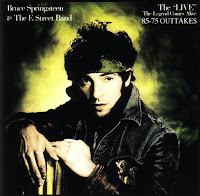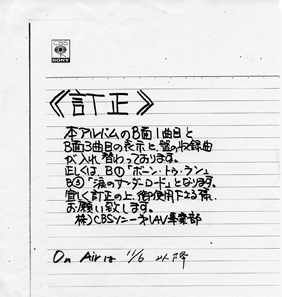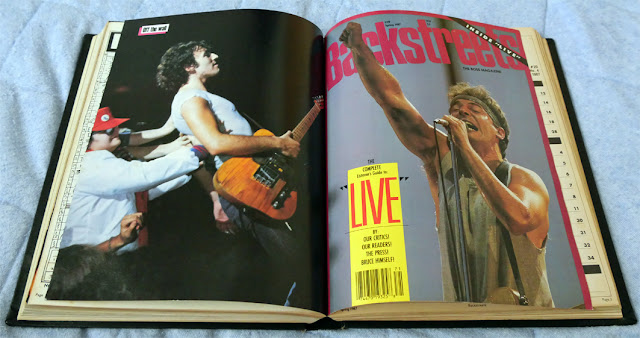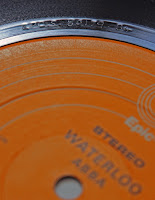Japan may initially have received high praise overseas for keeping low the number of
COVID-19 contagions. However, the unusual lifestyle continues, and the infected people increase to serious levels in some metropolitan areas these days, especially after introducing government-backed discount programs for food-service and travel industries to boost the economy hopefully. Yes, we recognize that the third wave has come here. Although not able to get deep into blogging activities under the current situation, my collecting effort has not been discontinued. Here is a brief summation of the selected recent results (mostly through domestic online auction).
LETTER TO YOU (
Columbia19439803801,
Euro-pressed black & white splatter vinyl)
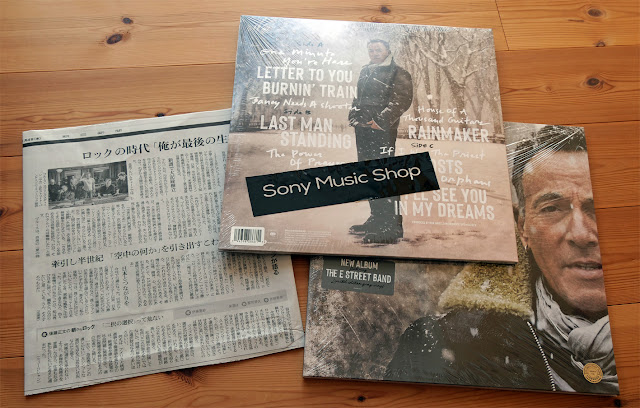 |
While I ordered the splatter version (center) from Sony Music Shop, the grey vinyl (right) was obtained at Tower Records (available there probably at the cheapest in Japan when ordering). A newspaper clipping on the left features the album review from the morning edition (November 4th, 2020) of the Asahi Shinbun, a major Japanese newspaper.
|
In the middle of last month, I noticed that Sony Music (Japan) took pre-orders for this store-exclusive version of the new LP. I just ordered a copy because I figured the fixed retail price [4,747 Yen, including consumption tax (10%); free shipping] was still cheaper than the total expense when making the order overseas, especially considering the costly international postage. The retail price also meant that it must have been a straightforward import, nothing like the specially treated previous two releases in Japan, CHAPTER & VERSE (SIJP 29-30; 6,000 Yen excluding tax) and WESTERN STARS (SIJP 86; 6,380 Yen including tax). Indeed, the copy I received on October 24th was just a sealed Euro pressing, with none of OBI, Japan-only booklet, and slick insert sheet to modify the rear sleeve (for company credit and barcode revision). Honestly, I didn't expect much for this release, and having known the inclusion of three re-recordings from the 1970s, I guessed that it would have been a mixed-bag assortment like HIGH HOPES (Columbia 88843 01546 1). Surprisingly, however, the album is nicely done (although I still prefer WESTERN STARS to the latest one). Nostalgic, but the vocal is young, fresh, and strong, backed solidly by the E Street sound. My complaint is directed to the disc number that should have been a single, but not a double, for both playing and listening convenience (i.e., two sides are better than three).
COMMEMORATIVE COMPACT DISCS (SONY TDCD 90042-90043)
 |
The tetra-folded custom-double CD holder fits comfortably into the thick cardboard slipcase (new addition; backward), which is missing in the previously obtained copy (forward; shown also here before). I still don't know what the CD set commemorated at Sony, Japan, back in 1991 when it was released.
|
Although I'm primarily a vinyl collector, I own a fair amount of CD collection, too, as I occasionally displayed or mentioned some of them in this blog. Shown here is a gorgeously packaged, promotion-only double-CD compilation (w/ Born In The U.S.A., Track 6 on Disc 2) released in 1991 from Sony Music Entertainment (Japan) Inc. This set was already introduced here a year ago (9/30/2019), and recently, I obtained and added another (second) copy to the collection. That was not for the investment, but because until recently, I did not know that my first copy was incomplete. This summer, I found this seldom come-across rarity on an online auction where the custom double-CD holder was housed in a specially designed, sturdy cardboard slipcase. My first copy lacked this essential piece from the full package. On collecting, nothing is better than owning a complete set, and that's why I had to get the second one. BTW, the Lost In The Flood collector's page does not mention the slipcase on the item description because it was me who reported this gorgeous Japanese collectible to the website a long time ago, not knowing that the outer case was missing from the first copy.
THE WILD, THE INNOCENT & THE E STREET SHUFFLE
(CBS/SONY SOPL-239 with a 4-page promotional biography)
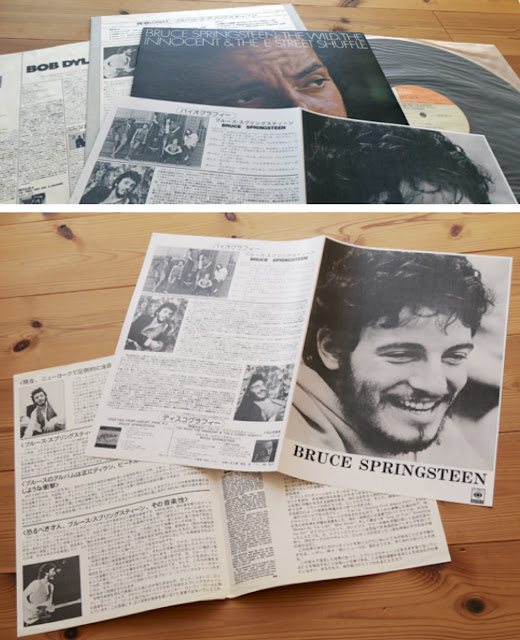 |
Besides the promo biography, the latest addition came with a standard
disc, a printed inner sleeve, and a foldout sheet including liner notes
with lyrics in English and Japanese, but lacked the OBI (upper).
Both sides of the biography (lower).
|
The Japanese edition of the second LP (the first press) has at least two appeals to vinyl collectors. One is a typological error on the OBI strip that is unique to the white-label promotional issues (
04/26/2015). The other is a 4-page folded booklet of biography that was originally accompanied by some copies of the promotional and regular pressings (
04/29/2015). Both are hard to come by even here in the Far East (and highly-priced even if found). The latter most probably represents Springsteen's first-ever promotional booklet or pamphlet officially released by
CBS/SONY Records, since the LP is his debut album here March 21st, 1974, preceding
GREETINGS FROM ASBURY PARK, N.J. (
CBS/SONY SOPL-248) that is out later on July 21st that year. To the best of my knowledge,
Blinded By The Light (P. Humphries & C. Hunt, 1985, Plexus, London) is the only reference source that mentions this promo print, although the book describes it erroneously as "a
5 page biography" (p. 168). Luckily, I found and grabbed it for less than 2,000 Yen last month in a net auction without competition.
THE MUSE CONCERT / NO NUKES laserdisc (
Videoarts Japan Inc., VALJ-3138)
 |
| Playing the guitar outro for Prove It All Night on the second night (Sep. 22nd) ? Sourced from this laserdisc or videotape, the pirate DVD has been produced and circulated. The accompanying liner-note sheet is quite hard to read through due to low-contrast orange & white printing. |
Even if not among the best performances, the
Musicians United for Safe Energy (
MUSE) Concerts For a
Non-Nuclear Future (
NO NUKES), held in
New York City in 1979 during recording sessions for
THE RIVER, are historically among the most significant in his career. A total of five performances from the two-night stand are included in the
triple-disc soundtrack LP (
Stay and
Devil With The Blue Dress Medley) and the 103-min documentary film (
The River,
Thunder Road, and
Quarter To Three), which are later released as a double CD and visual format (videotape and laserdisc), respectively. Collecting-wise, two versions of the promotion-only
Devil ... 12" vinyl disc, which are played at different speeds, have been popular classic collectibles, with the 33⅓-rpm edition being impossibly rare (see
04/25/2019 to
05/12/2019).
Although I have never owned laser-disc players, this title in the now-defunct format is worth getting for the front sleeve alone. I obtained the Japanese edition at fairly a cheap price (480 Yen; the fixed retailed price was 5,800 Yen back then, excluding consumption tax). In my opinion, it features one of the best live-stage shots used for official 12-inch sized sleeves, along with
AS REQUESTED AROUND THE WORLD (
05/10/2020 to
06/06/2020). As already pointed out, several previously unseen clips from the charity concerts are used on the documentary and music video from
LETTER TO YOU, indicating that there should be the complete performance footage for each night by Springsteen and the band. Wishing the full part of Springsteen's footage to be officially released from the vault.

